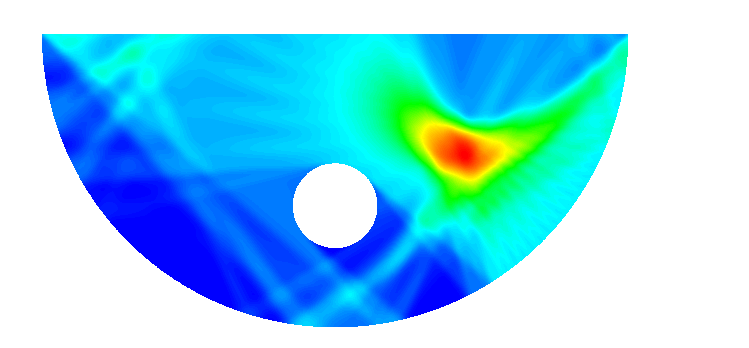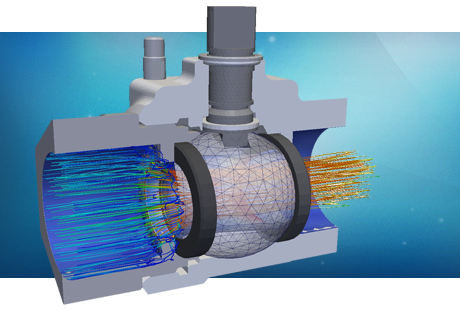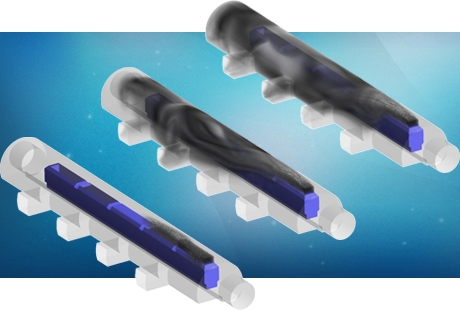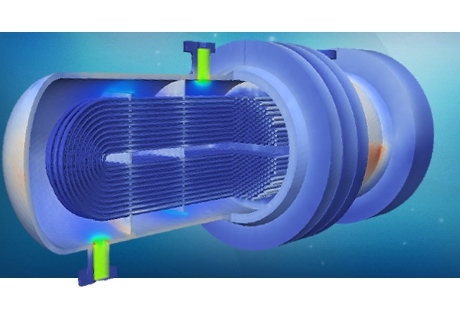Solar power
Solar power industry is constantly evolving. Changes in subsidies and incentive schemes in the different EU countries, political decisions affecting the supply chain in the Eastern countries and the introduction of new technologies make the solar power one of the most dynamic markets in industry.
With most EU countries approaching or trespassing the grid parity threshold (the point at which the cost of solar electricity is equal to or cheaper than the price of grid power) due to higher fossil fuel prices and lower solar equipment costs, solar power technologies have gained credibility as a real alternative to current power generation mix, highly dominated by coal, gas and fuel burning.
From relatively tested technology such as polycrystalline photovoltaics to new technological developments such as thin film technology or ultra-high concentration thermal applications, the sector can profit from simulation and mathematical modelling.

Mechanical evaluations such as stress and fatigue analyses of collectors and panels under wind and snow loads or vibrational performance studies can be performed using finite element analysis. Additionally, evaluations of concentrating applications to assess efficiency and yield under different radiation conditions can be performed using computational fluid dynamics. PRE Technologies have more than 25 years of combined experience in different solar power projects. We can help you gain the insight you need to optimise your designs.
Solar photovoltaic power
In an environment where feed-in tariffs and renewables obligation certificates are gradually decreasing, the sector is striving to reach grid parity by testing new concepts, further developing existing technologies and working with the supply chain to reduce costs. In those three fronts, simulation and mathematical modelling can play a very relevant role. You can evaluate new concepts without the need of producing expensive prototypes and performing time consuming tests. Also it may help you develop existing technologies by iteratively optimizing your designs, again without the need of physical tests. Finally, simulation can help you reduce your investment and operational costs by analysing alternative materials and production techniques early in the design stage, which could then be implemented all along the supply chain.

Mono or polycrystalyne technologies, thin film and concentrated photovoltaics can take advantage of simulation tools in every stage of the development process and spot potential mechanical or thermal failures using quick and reliable virtual prototypes.
Solar thermal power
Commercial concentrated solar power plants were first developed in the 1980s. A wide range of concentrating technologies exist, being the most developed the parabolic trough, the concentrating linear fresnel reflector, the Stirling dish and the solar power tower. One of the main advantages of CSP is the ability to efficiently add thermal storage, allowing the dispatching of electricity over up to a 24-hour period.
PRE Technologies has extensive experience in concentrated solar thermal applications. We can offer simulation services that aid the design of the different elements of any solar thermal system:
-
 Collector:Whether it is a parabolic trough, a Fresnel lens, heliostats for a power tower, or dish systems, collectors can be optimised using simulation techniques. Evaluating geometries for static and tracking systems in terms of overall year-round performance is possible using optical simulations for direct and difuse radiation. Supports and trackers are also susceptible of stress, fatigue and vibrational simulations and need to comply with building regulations for wind and snow loads.
Collector:Whether it is a parabolic trough, a Fresnel lens, heliostats for a power tower, or dish systems, collectors can be optimised using simulation techniques. Evaluating geometries for static and tracking systems in terms of overall year-round performance is possible using optical simulations for direct and difuse radiation. Supports and trackers are also susceptible of stress, fatigue and vibrational simulations and need to comply with building regulations for wind and snow loads.
-
 Receiver:From standard absorber materials and vacuum tubes for low concentration applications to state of the art fluidized-bed particle and direct supercritical carbon-dioxide receivers, CFD and FEA tools can help you get a valuable insight of the system’s performance.
Receiver:From standard absorber materials and vacuum tubes for low concentration applications to state of the art fluidized-bed particle and direct supercritical carbon-dioxide receivers, CFD and FEA tools can help you get a valuable insight of the system’s performance.
- Power Block:From conventional thermodynamic power cycles currently employed throughout the power generation industry, including Rankine and Stirling cycles to more exotic solutions there is always room for further efficiency optimisation, which can have a huge impact on a plant’s revenues. tab.
- Storage:Multiple storage solutions are being developed, such as molten salt storage, phase change materials (PCMs) and water pumping for hydroelectricity. However, more sophisticated methods like artificial photosynthesis are currently being researched. CFD thermal studies are of great help in these developments as they allow the designer to run complex efficiency calculations in a relatively inexpensive and quick way.
We care about the reliability of our models and try to provide meaningful solutions that can be implemented in an industrial scale. That is why we follow all relevant standards and best practice guidelines for both PV systems (BS, UL and IEC) and thermal applications (EN 12975 and EN 12976).
For more information on other services for the energy sector, please go to the renewable energy services tab or contact us here.
Our services for this sector
Solar thermal:
-
Collectors and trackers
- Stress, vibrational and fatigue studies of trackers and collector structures (wind and snow conditions)
- Optics and performance of different collectors and tracking angles
- Thermal studies for direct and diffuse radiation
-
Receivers
- Thermal performance for different absorbing materials and vacuum conditions
- Optics performance for different receiver geometries
- Efficiency study for different thermal fluids and flow rates.
-
Power block and storage
- Efficiency study of different thermodynamical cycles
- Optimisation of energy storage methods
- PCM thermal simulations
Solar photovoltaics:
- Stress, vibrational and fatigue studies of trackers and supporting structures (wind and snow conditions)
- Radiation and convection models for temperature build-up
- Module frame mechanical optimisation







